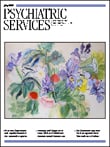Letters
Psychosocial Functioning of Medicaid Recipients With Major Depression
To the Editor: Confounding of treatment selection by illness severity threatens many nonexperimental observational research designs that use administrative data to study mood disorders ( 1 , 2 ). In a study of antidepressants and suicide, for example, if depressed patients who receive antidepressants are more severely ill than ostensibly similar depressed patients who do not receive antidepressants, an observed association between antidepressant treatment and suicide may simply reflect this underlying selection bias. Because measures of illness severity are not routinely available in administrative data sets, it is unclear whether or to what extent this bias exists.
We sought to evaluate whether psychosocial functioning differs among patients with major depressive disorder on the basis of their use of antidepressant medications or psychotherapy. We merged a 1993-1994 Medicaid claims database containing patient diagnostic and service use data with a community-tracking database that includes a clinician-administered Global Assessment of Functioning (GAF) ( 3 ) rating. During this period, there was a low level of managed care penetration and a high level of data completeness. Patients selected had received a diagnosis of major depressive disorder ( ICD-9 codes 296.2 or 296.3) that was preceded by a period of at least 60 days without antidepressant treatment and had also received a GAF rating within 60 days preceding the first noted diagnosis of major depressive disorder. Filled prescriptions for antidepressant medications were noted in the 60 days after the diagnosis of major depression. A similar algorithm was used to examine GAF ratings and use of psychotherapy.
A total of 472 patients were identified for the antidepressant analysis; 159 (34 percent) had filled a prescription for an antidepressant in the 60 days after the diagnosis of major depressive disorder. The mean±SD GAF score of the group that initiated antidepressant medications (49.6±13.1) did not significantly differ from that of the group that did not initiate antidepressants (50.1±11.7). The GAF score of the 341 patients who received psychotherapy (50.3±12.2) was similar to that of the 175 patients who did not receive psychotherapy (49.7±12.0). The findings stratified by age (six to 20 years and 21 years and older) directly mirrored the overall findings for both antidepressant and psychotherapy use.
Under these conditions, neither initiation of antidepressant medication nor psychotherapy treatment was significantly related to illness severity as measured by a clinician-administered GAF.
The study's limitations include relatively small samples, a concern that clinician-administered GAF ratings are only weakly related to function and outcome ( 4 ), an absence of documented standardization of the GAF ratings, and temporal delays between the GAF ratings and treatment. Within the context of these limitations, the similarities in mean GAF ratings for these groups may help to reduce concern over confounding of treatment initiation and illness severity.
1. Valuck RJ, Libby AM, Sills MR, et al: Antidepressant treatment and risk of suicide attempt by adolescents with major depressive disorder. CNS Drugs 18:1119-1132, 2004Google Scholar
2. Goodwin FX, Fireman B, Simon GE, et al: Suicide risk in bipolar disorder during treatment with lithium and divalproex. JAMA 290:1467-1473, 2003Google Scholar
3. Diagnostic and Statistical Manual of Mental Disorders, 4th ed. Washington, DC, American Psychiatric Association, 1994Google Scholar
4. Moos RH, Nichol AC, Moos BS: Global Assessment of Functioning ratings and the allocation and outcomes of mental health services. Psychiatric Services 53:730-737, 2002Google Scholar



